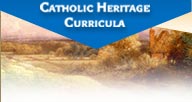| Answer: |
Dear Parent,
Thank you for your question!
Christ and the Americas and Christ the King, Lord of History, are suggested as reference texts, and are fine for that purpose. If they were to be used as the "spine" and sole texts for a student's history course, [tests and all!] they might be a bit challenging to a 7th or 8th grader. However, they are excellent reference texts for 7th or 8th graders to read and get a general idea of people and events of the time.
In regard to combining the 6th and 7th grader next year, your course of action would be based on the abilities and goals of the students. With homeschooling, you can certainly tailor the assignments and requirements based on the ability of the student. Thus, more might be expected of the 7th grader than of the 6th grader.
In regard to the 5-Question Paper, the younger student might simply be asked to answer the five questions in a single paragraph. [See "Five Question" Paper boxes peppered throughout the 7th grade timeline in the lesson plans.] You might even modify the 6th grader's assignment to answering the"5 W's': Who, What, Where, When, and Why. E.g., Christopher Columbus discovered America in 1492 because he was looking for a trade route to India . That one sentence answers all 5 W's, although you might ask that the student write more than one sentence!
If your students are heavily resistant to reading, they might glean the information by researching Christopher Columbus [or whomever] on the internet, or by watching historical videos from the library and taking notes. The key is to expose them to history, and then require them to demonstrate in some fashion that learning has taken place. Perhaps they might like to create a drawing depicting Columbus' voyage, or simply take notes and relate orally to you what they learned. [See also the history Enhancement Activities, which may be substituted in the case of severely resistant writers.]
Expectations for reading and writing may be as low or as high as you wish. Do keep in mind that, as students progress toward high school and college, reading and writing skills grow ever more essential. The only way those skills can be developed is by practicing them, first in small and then gradually increasing increments. Children tend to resist challenges and will advance only if they are given challenges---and they can be small, at first----and expected to deliver. In time, what once seemed impossible is conquered. [Think of learning to tie their shoes!]
One purpose of the reading is to give the student topics from which he might select people or events that interest him. For example, a student might not be particularly interested in the character of Columbus, but might find his ships to be interesting. If he is allowed to research the Nina, Pinta, and Santa Maria, he might read and write with more enthusiasm and also learn about Columbus in the process.
God bless you and your family!
Laura Corrigan |

